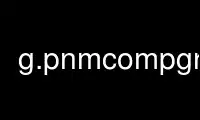
This is the command g.pnmcompgrass that can be run in the OnWorks free hosting provider using one of our multiple free online workstations such as Ubuntu Online, Fedora Online, Windows online emulator or MAC OS online emulator
PROGRAM:
NAME
g.pnmcomp - Overlays multiple PPM image files.
KEYWORDS
general, display
SYNOPSIS
g.pnmcomp
g.pnmcomp --help
g.pnmcomp input=name[,name,...] [mask=name[,name,...]] [opacity=float[,float,...]]
output=name [output_mask=name] width=integer height=integer [bgcolor=name]
[--overwrite] [--help] [--verbose] [--quiet] [--ui]
Flags:
--overwrite
Allow output files to overwrite existing files
--help
Print usage summary
--verbose
Verbose module output
--quiet
Quiet module output
--ui
Force launching GUI dialog
Parameters:
input=name[,name,...] [required]
Name of input file(s)
mask=name[,name,...]
Name of input mask file(s)
opacity=float[,float,...]
Layer opacities
output=name [required]
Name for output file
output_mask=name
Name for output mask file
width=integer [required]
Image width
height=integer [required]
Image height
bgcolor=name
Background color
Either a standard color name or R:G:B triplet
DESCRIPTION
g.pnmcomp isn’t meant for end users. It’s an internal tool for use by wxGUI.
In essence, g.pnmcomp generates a PPM image by overlaying a series of PPM/PGM pairs (PPM =
RGB image, PGM = alpha channel).
NOTES
The intention is that d.* modules will emit PPM/PGM pairs (by way of the PNG-driver code
being integrated into Display Library). The GUI will manage a set of layers; each layer
consists of the data necessary to generate a PPM/PGM pair. Whenever the layer "stack"
changes (by adding, removing, hiding, showing or re-ordering layers), the GUI will render
any layers for which it doesn’t already have the PPM/PGM pair, then re-run g.pnmcomp to
generate the final image (just redoing the composition is a lot faster than redrawing
everything).
A C/C++ GUI would either have g.pnmcomp’s functionality (image composition) built-in, or
would use the system’s graphics API to perform composition (for translucent layers, you
would need OpenGL or the Render extension, or something else which supports translucent
rendering).
Tk doesn’t support transparent (masked) true-colour images (it does support transparent
GIFs, but that’s limited to 256 colours), and an image composition routine in Tcl would be
unacceptably slow, hence the existence of g.pnmcomp.
Use g.pnmcompgrass online using onworks.net services
